The Shri Ram Mandir in Ayodhya has a long-standing history that is firmly embedded in Hindu mythology and legends, dating back to ancient times. At the heart of this temple’s story is the esteemed Lord Rama, a highly revered deity in Hinduism, and the epic saga of the Ramayana. This captivating narrative, brimming with mythological aspects and cultural importance, has profoundly influenced the beliefs and emotions of countless Hindus throughout the ages.
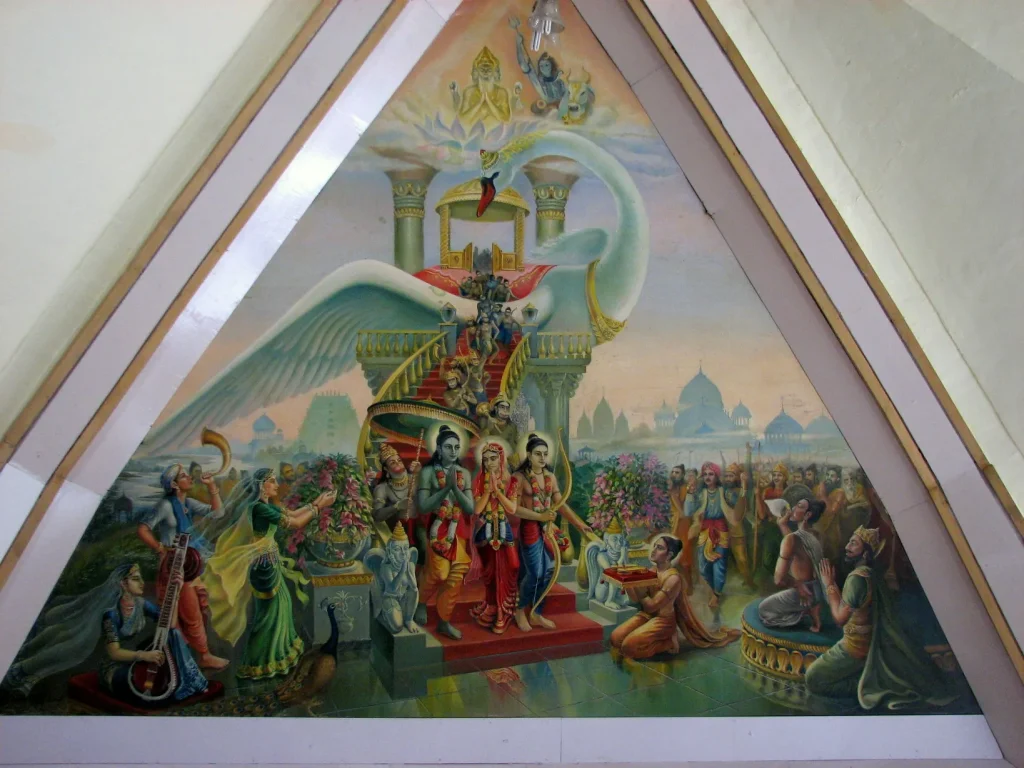
“Mythical Underpinnings: Unraveling the Foundations of Legend”
The origins of the Shri Ram Mandir can be traced back to the Ramayana, an ancient Hindu epic written by the sage Valmiki. This epic tells the story of Lord Rama, who is considered the seventh incarnation of Lord Vishnu. According to Hindu mythology, Lord Rama was born in Ayodhya to King Dasharatha and Queen Kaushalya.
The Ramayana begins with the divine birth of Rama and his three brothers, Bharata, Lakshmana, and Shatrughna. Rama’s early life revolves around his marriage to Sita, who is believed to be an incarnation of the goddess Lakshmi. However, Rama’s exile to the forest, which was orchestrated by his stepmother Kaikeyi, sets off a chain of events that ultimately leads to the epic battle against the demon king Ravana.
The most significant episode in the Ramayana, known as the “Ramayana Yuddha” or the Battle of Lanka, concludes with Rama’s triumph over Ravana and the rescue of Sita. Upon their victorious return to Ayodhya, Rama is crowned as the king, ushering in the era of “Ram Rajya,” which is considered an ideal rule. The narrative of the Ramayana encompasses themes of duty, righteousness, and the ultimate victory of good over evil.
Ayodhya, renowned as the Holy Dwelling:

Ayodhya, the birthplace of Lord Rama, holds immense significance in Hindu tradition. It is revered as a symbol of righteousness and an exemplary kingdom. The belief that Ayodhya is the divine abode of Lord Rama has been passed down through generations, creating a profound emotional and spiritual bond for Hindus.
According to the Ramayana, Ayodhya is described as a splendid city adorned with majestic palaces, lush gardens, and virtuous inhabitants. The epic paints a vivid picture of a utopian society under Rama’s reign, highlighting principles of fairness, morality, and empathy. The association of Ayodhya with Lord Rama’s birth elevates the city to a sacred destination for pilgrims seeking a connection with the divine.
The Janmabhoomi and the Babri Mosque:
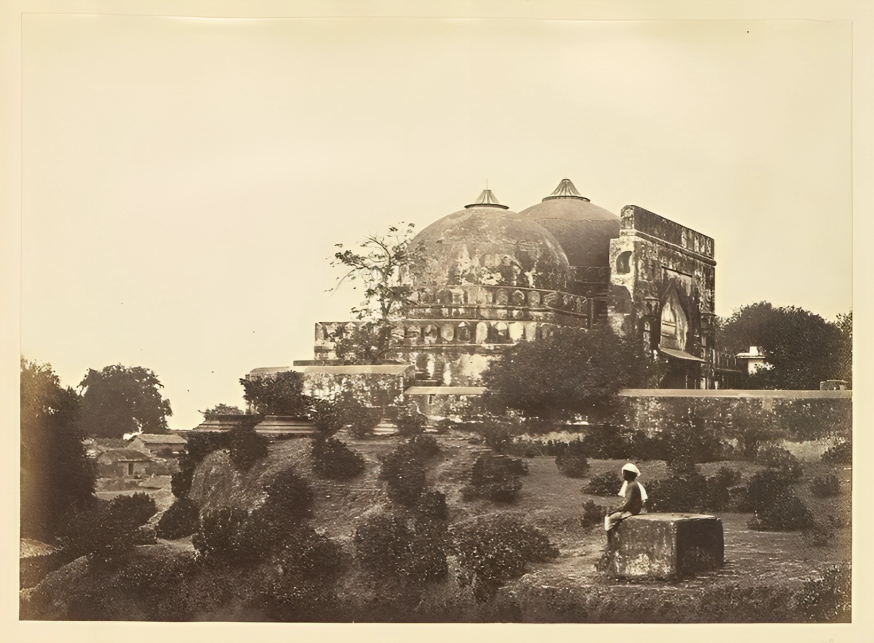
The Janmabhoomi, meaning “birthplace” in Sanskrit, holds great significance in the narrative of the Ramayana, with Ayodhya’s Janmabhoomi being the focal point. It is believed to be the exact location where Lord Rama was born, making it a sacred site revered by devotees. However, this sacredness has also led to a historical and religious controversy.
The controversy revolves around the construction of the Babri Mosque in Ayodhya during the Mughal period. Historical accounts state that the mosque was built in the 16th century by Mir Baqi, a commander of the Mughal emperor Babur. However, local Hindu belief, based on the Ramayana, claims that the mosque was constructed on the very spot considered to be Lord Rama’s birthplace.
These conflicting claims over the Janmabhoomi have resulted in tensions and disputes that have persisted over the centuries. While the mosque stood as a symbol of religious and cultural coexistence, it also became a source of contention, particularly in more recent times.
“Contemporary Ram Janmabhoomi Movement: A Modern Perspective on the Ayodhya Saga”
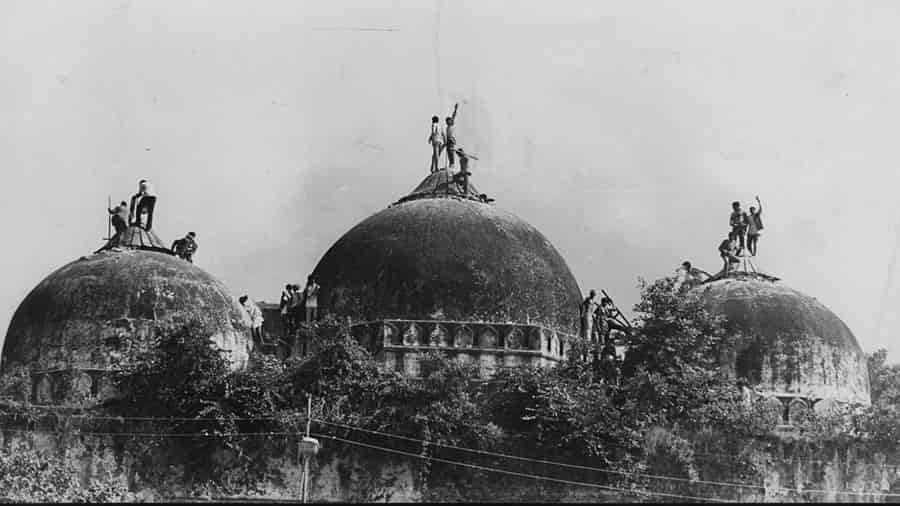
Historical accounts and records from travelers and scholars shed light on the changing narrative surrounding the Janmabhoomi in Ayodhya. In 1611, English traveler William Finch documented the ruins in Ayodhya but did not mention a mosque. However, accounts like Lal Das’s Awadh-Vilasa in the 17th century suggest the presence of a mosque at the site.
During the 18th century, Jesuit missionary Joseph Tiefenthaler visited Ayodhya and wrote about the demolition of a fortress linked to Lord Rama, followed by the construction of a mosque in its place. Subsequent visitors, including Francis Buchanan in 1810, observed that a temple dedicated to Rama had been replaced by the mosque.
The authenticity of inscriptions on the Babri Mosque remains controversial, with claims that they were added much later, casting doubt on the mosque’s historical connection to Babur’s era. This debate adds complexity to the ongoing Janmabhoomi saga.
The Demolition of Babri Mosque: Unraveling a Controversial Chapter in History
On December 6, 1992, the Ram Janmabhoomi movement reached its climax as a significant number of kar sevaks (volunteers) gathered at the disputed site in Ayodhya, under the joint organization of the VHP and the Bharatiya Janata Party (BJP). Unfortunately, the situation escalated and resulted in the violent demolition of the Babri Mosque.
The consequences of this mosque demolition were profound, as it ignited inter-communal riots and heightened tensions between India’s Hindu and Muslim communities. Furthermore, the incident had repercussions beyond India’s borders, as there were reports of attacks on Hindu temples in Pakistan and Bangladesh.
Findings of the Archaeological Survey of India:
The site’s archaeological evidence was studied through two significant excavations conducted by the Archaeological Survey of India (ASI). The first excavation, led by B. B. Lal, resulted in the discovery of 12 pillars of the mosque, which were made from the remains of a Hindu temple. These pillars were adorned with Purna Kalasha symbols, commonly found in temples from the 12th and 13th centuries. Additionally, terracotta sculptures depicting human beings and animals were unearthed, aligning with the characteristics of a temple.
During the second excavation in 2003, over 50 pillars were uncovered, further strengthening the belief that a Hindu temple once stood beneath the mosque. The excavators also found various architectural elements such as the temple system known as ‘pranali’ and the ‘shikhara.’ Moreover, the discovery of 263 terracotta remains, including depictions of gods, goddesses, and human figures, provided additional evidence supporting the existence of a temple.
Notably, two remains at the site bore an inscription of ‘Vishnu Hari Shila Phalak,’ which served as further confirmation of the presence of a Hindu temple.
The Judicial Struggle: Legal Challenges and the Landmark Verdict of the Supreme Court
Following the demolition of the Babri Mosque, a series of legal disputes emerged regarding the ownership and status of the contested area. Numerous parties engaged in title disputes and legal proceedings, each asserting their claims to the land.
The culmination of this case came when the Supreme Court of India issued a significant judgment on November 9, 2019. In its ruling, the court favored the construction of a Ram temple at the Janmabhoomi site, while also instructing the allocation of a separate parcel of land in Ayodhya for the construction of a mosque.
Establishment of Shri Ram Janmabhoomi Teerth Kshetra
After the Supreme Court ruling, the Indian government established the Shri Ram Janmabhoomi Teerth Kshetra, a trust assigned with the task of supervising the building of the Ram temple. Comprised of notable individuals, the trust was bestowed with the duty of raising funds, devising plans, and carrying out the construction process.
“Initiation of Temple Construction: A New Chapter Begins”
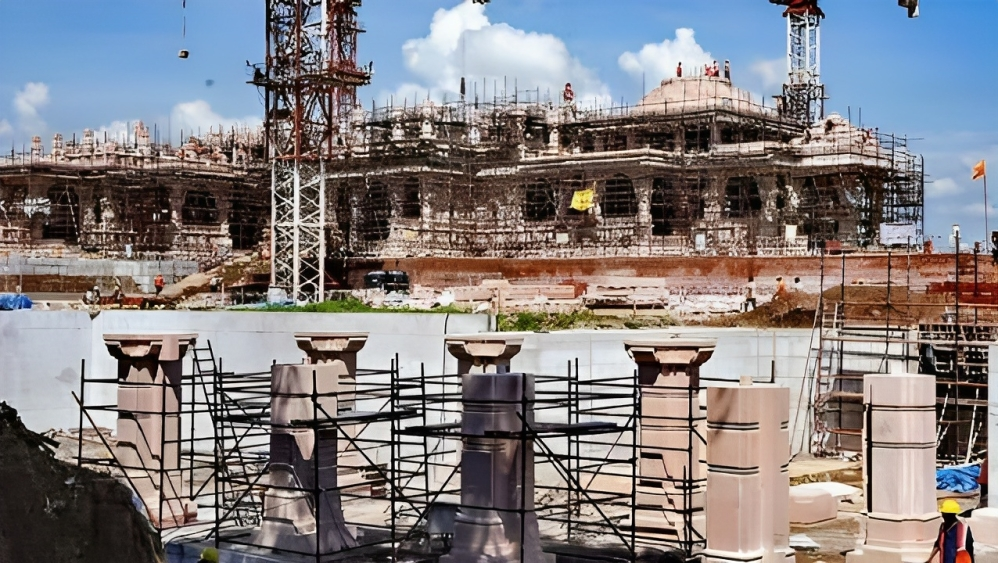
In March 2020, the construction of the Ram temple began, and Prime Minister Narendra Modi conducted the foundation stone-laying ceremony on August 5, 2020. This event held great importance for the cultural and religious history of Ayodhya and India as a whole.
Despite facing temporary suspensions, including one caused by the COVID-19 pandemic, the construction process persisted. By May 2023, significant advancements had been achieved, with 70% of the groundwork and 40% of the roof work successfully completed.
The installation of the idol of Lord Ram:
The installation of the idol of Lord Ram in the garbhagriha has been scheduled for January 22, 2024. Leading the consecration ceremony will be Champat Rai, the General Secretary of the Shri Ram Janmbhoomi Teerth Kshetra Trust. A formal invitation has been extended to Prime Minister Narendra Modi to grace the auspicious occasion.
Different quarters have expressed a range of reactions to the construction of the Ram temple. Concerns have been raised by certain priests and religious leaders regarding deviations from proper ritual procedures during the ceremonies. Additionally, criticism has emerged regarding the selected date of August 5, which coincided with the one-year anniversary of the revocation of Jammu and Kashmir’s special status.
Pakistan has officially criticized India for initiating the construction, citing historical disputes related to the site. On the other hand, several Indian political leaders have lauded the ground-breaking ceremony, emphasizing its cultural and religious importance.
“Current Advancements and Upcoming Initiatives”
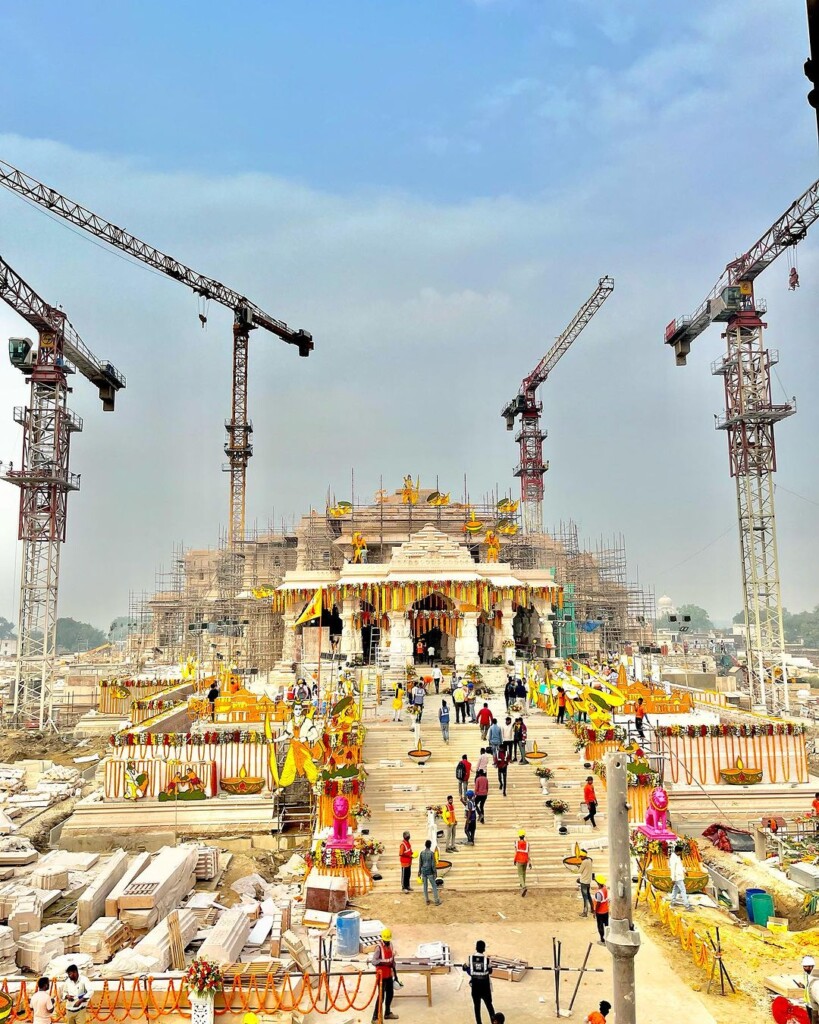
In August 2021, an open-air location was established to provide the public with the opportunity to witness the ongoing construction. The process of clearing debris and laying the foundation continued, and by mid-September 2021, approximately 47-48 layers of roller-compacted concrete had been successfully completed.
In January 2023, two Shaligram rocks, believed to be around 60 million years old and weighing 26 and 14 tonnes respectively, were sourced from the Gandaki River in Nepal. These rocks were skillfully utilized in the intricate carving of the idol of Ram Lalla, which now resides in the innermost chamber of the temple. As of May 2023, the Shri Ram Janmabhoomi Teerth Kshetra Trust reported significant progress, with 70% of the groundwork and 40% of the roof work already accomplished.
The Consecration of Ram Mandir and Ramotsav
Preparations are currently underway for the consecration ceremony known as pran pratishtha, with the Uttar Pradesh government setting aside ₹100 crore for a series of religious events called ‘Ramotsav’ that will take place across 826 local bodies. These events began in December 2023 and will culminate in grand celebrations starting from Makar Sankranti on January 14/15 and leading up to the inauguration of the Ram temple on January 22.
The consecration ceremony has garnered the attention of Prime Minister Narendra Modi, who, along with other political leaders and dignitaries, has received an invitation to attend. The guest list includes industrialists, scientists, actors, army officers, spiritual leaders, and awardees.
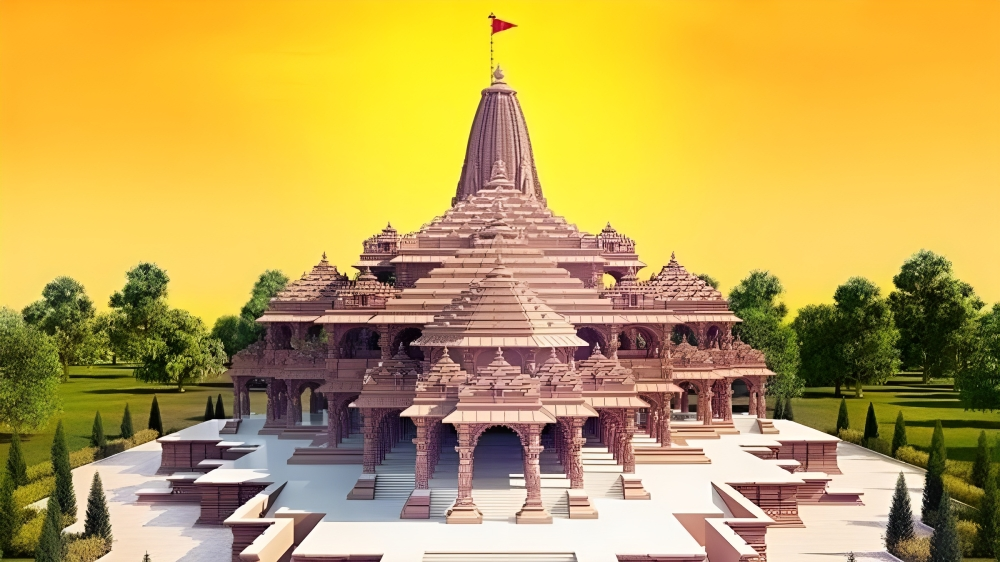
The Shri Ram Mandir in Ayodhya has a rich history that intertwines mythology, legends, historical events, and contemporary socio-political movements. Its significance goes beyond religious boundaries, capturing the cultural and emotional essence of millions of individuals. The construction of the Ram temple symbolizes not only a physical edifice, but also a representation of faith, resilience, and the lasting impact of the epic tale of Lord Rama. As the consecration ceremony draws near, it signifies a pivotal moment in India’s cultural landscape, reaffirming the profound connection between mythology, history, and the collective consciousness of its people.

